 |
 |
 |
| |
Vicriviroc Phase 3 Trial and Naive
Study May Afford New Angle on Role of CCR5 Blockers
|
| |
| |
Targeting HIV Entry: 4th International Workshop,
December 8-9, 2008, Rio Grande, Puerto Rico
Mark Mascolini
Phase 3 trials of vicriviroc, the CCR5 antagonist that works best in a ritonavir-boosted regimen, are fully enrolled [1]. And some baseline data suggest differences between this phase 3 study population and those in recent salvage trials could afford further insights into the eventual role of CCR5 antagonists. But those differences may also make the results harder to interpret. At the same time Schering's Lisa Dunkle offered a new analysis of pooled results from phase 2 trials, issued an update on cancer incidence among vicriviroc takers, and outlined a novel trial of this CCR5 antagonist in previously untreated people.
VICTOR-E1, the largest reported trial of vicriviroc so far, tested the CCR5 inhibitor against placebo at doses of 20 or 30 mg once daily in antiretroviral-experienced people [2]. While 25% randomized to placebo plus an optimized background regimen had a viral load below 50 copies at week 48, 59% taking 30 mg of vicriviroc reached that mark [3]. Among people with one other active drug in the background regimen (besides vicriviroc), 63% taking 30 mg of vicriviroc and 27% taking placebo had a week-48 viral load under 50 copies. Sub-50-copy response rates measured 70% among people taking vicriviroc at 30 mg with a pretreatment load under 100,000 copies and 33% in those taking the same dose with a higher pretreatment load.
Both VICTOR-E1 and the earlier phase 2 vicriviroc trial, ACTG 5211 [4], had open-label extensions beyond 48 weeks. In both extensions, a combined 196 trial participants ended up taking 30 mg of vicriviroc once daily plus an optimized background regimen including a ritonavir-boosted protease inhibitor (PI). Through 96 weeks of follow-up on 108 people, the average viral load had dropped about 2 log (100-fold), and that downward trend continued--through week 120 in 54 people, and through week 192 in 13 people followed to that point. Meanwhile, the average CD4 count continued a steady climb, adding about 140 cells at week 96 (in 105 people followed), about 160 cells at week 144 (in 50 people), and about 180 cells at week 192 (in 12 people).
The surprise development of cancer in 6 people taking vicriviroc and 2 taking placebo in ACTG 5211 [4] ignited fears that plugging CCR5 coreceptors somehow touches off malignancies. Summarizing cancer reports among vicriviroc takers through June 2008, including 600 person-years of vicriviroc exposure, Dunkle counted only a handful of additional cancer cases as use of the drug soared. Except for a single early report of gastric carcinoma, all malignancies have been lymphomas or cutaneous cancers. Malignancies per 100 person-years peaked in June 2006 at around 6 and dropped to around 3 by June 2008.
VICTOR-E3 and E4 are the fully enrolled phase 3 trials of vicriviroc versus placebo plus an optimized background regimen in people with resistance to at least two of the first three antiretroviral classes or at least 6 months of treatment with at least two of the following: one nucleoside, one nonnucleoside, or two PIs (excluding low-dose ritonavir). In other words, a person responding well to first-line efavirenz plus two nucleosides for 6 months, but still troubled by efavirenz-inspired dreams, could have signed up for VICTOR-E3 or E4. Trial participants may have HBV or HCV coinfection, and all had CCR5-using virus when screened for the trials. As in other vicriviroc salvage studies, the background regimen must contain a ritonavir-enhanced PI.
The average baseline CD4 count of the 857 VICTOR-E3 and E4 enrollees is considerably higher (246, range 3 to 1475) than in phase 3 trials of maraviroc (191, range 2 to 820) or raltegravir (153, range 1 to 759), Dunkle reported. At the same time, about 65% of VICTOR-E3 and E4 enrollees have a phenotypic sensitivity score of 3 or more (indicating several active drugs in the background regimen), compared with about 40% in maraviroc phase 3 trials and 20% in raltegravir phase 3 trials. More than 90% of VICTOR-E3 and E4 participants have at least two active drugs in the background regimen, largely because more active salvage drugs and now available than during the maraviroc and raltegravir trials.
The good background combinations taken with vicriviroc will make it harder to sort out how much the CCR5 antagonist contributes to the virologic response. The higher baseline CD4 count will make progression slower in the placebo arm than in placebo arms of other recent optimized-background trials, but it could prove helpful in discerning the impact of a CCR5 antagonist in people with only moderately advanced HIV infection.
Dunkle made a case for CCR5 antagonist therapy in antiretroviral-naive people by tabulating results of three 2006-2008 studies that measured rates of CCR5-using virus in naive and experienced patients in four CD4 brackets--over 365, under 365, 135 to 257, and under 135. In all four brackets, even the advanced under-135 group, a significantly higher proportion of naive than experienced people had only R5 virus. Use of CCR5 antagonists, she argued, should not be confined to heavily experienced people needing a robust salvage regimen.
In a phase 3 trial of maraviroc in previously untreated people, that CCR5 antagonist could not match efavirenz virologically at week 48 when the pretreatment viral load stood above 100,000 copies [5]. (from Jules: but in the reanalyzed MERIT study reported at ICAAC where they used the enhanced Trofile test maraviroc performed equal to EFV in patients with <100,000 and >100,000 baseline viral load). Reanalysis of the MERIT Study with the Enhanced Trofile Assay (MERIT-ES)(10/28/08). Schering hopes to do better in a trial coupling vicriviroc with atazanavir/ritonavir--and no reverse transcriptase inhibitors--versus atazanavir/ritonavir plus tenofovir/emtricitabine. Stage 1 of this trial is fully enrolled with 95 people; a second stage will add another 120. The goal of this novel regimen, Dunkle explained, is to avoid nucleosides (and their long-term toxicities) and to reserve nonnucleosides for future use. Of course, a ritonavir-boosted PI is the perfect match for vicriviroc because ritonavir multiplies vicriviroc concentrations 5 to 6 times. The primary endpoint (curiously, for a trial in naive patients) is mean change in viral load. Percentage with a viral load below 50 copies is a secondary endpoint.
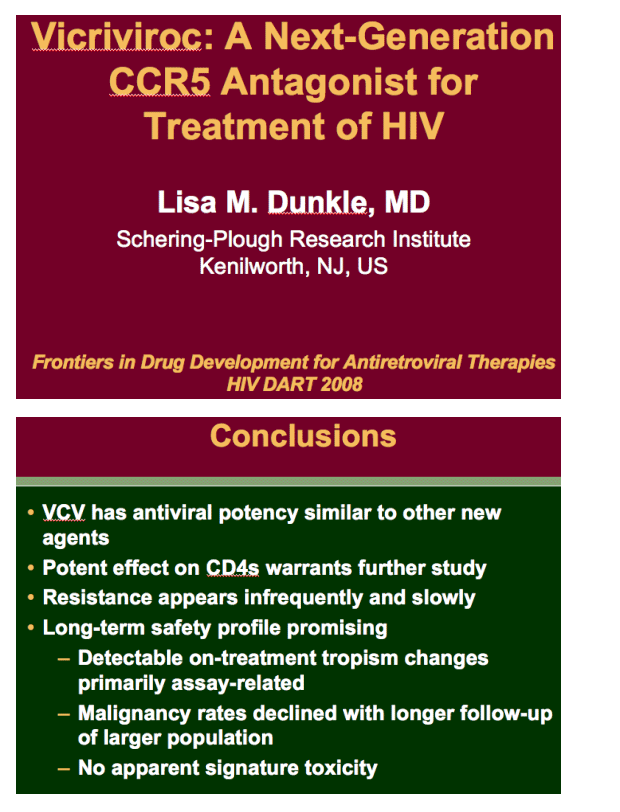

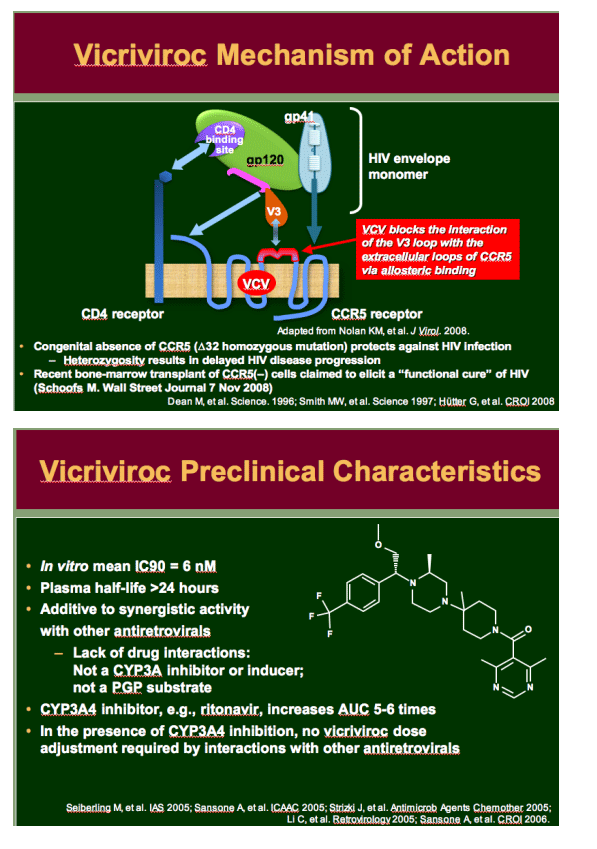
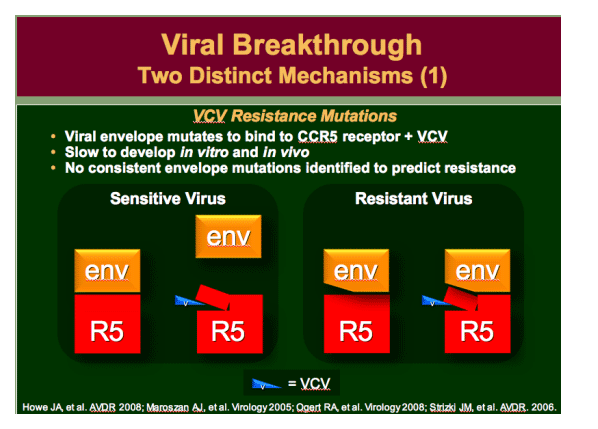

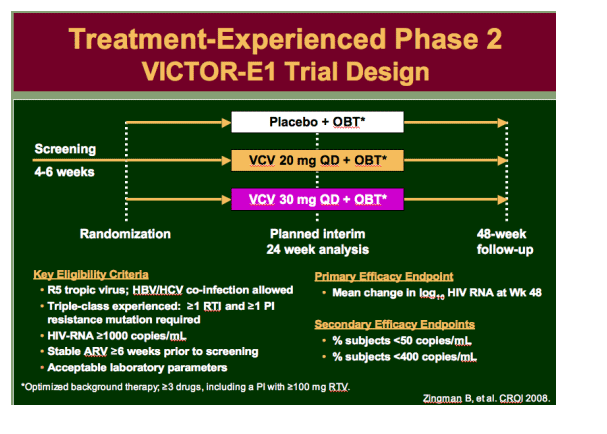
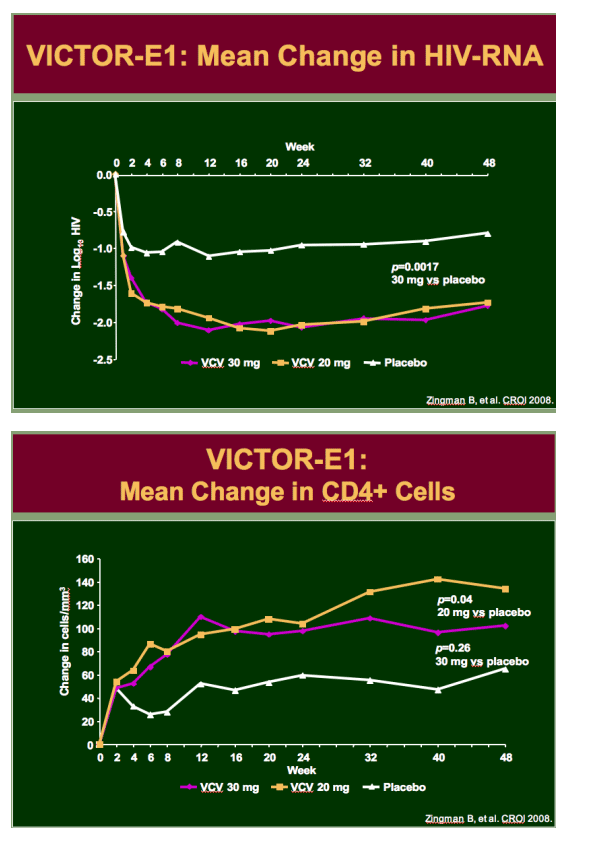
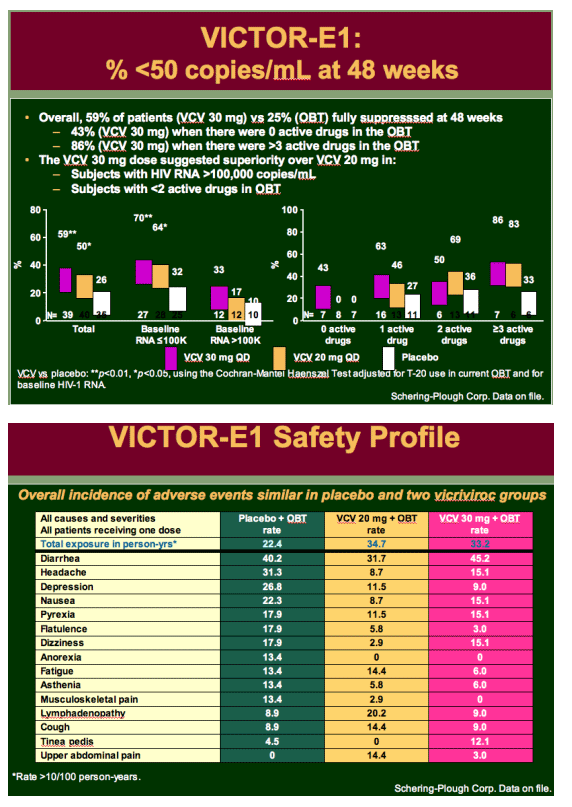
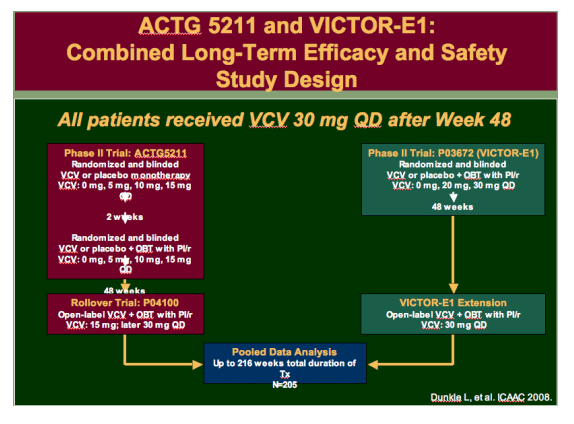
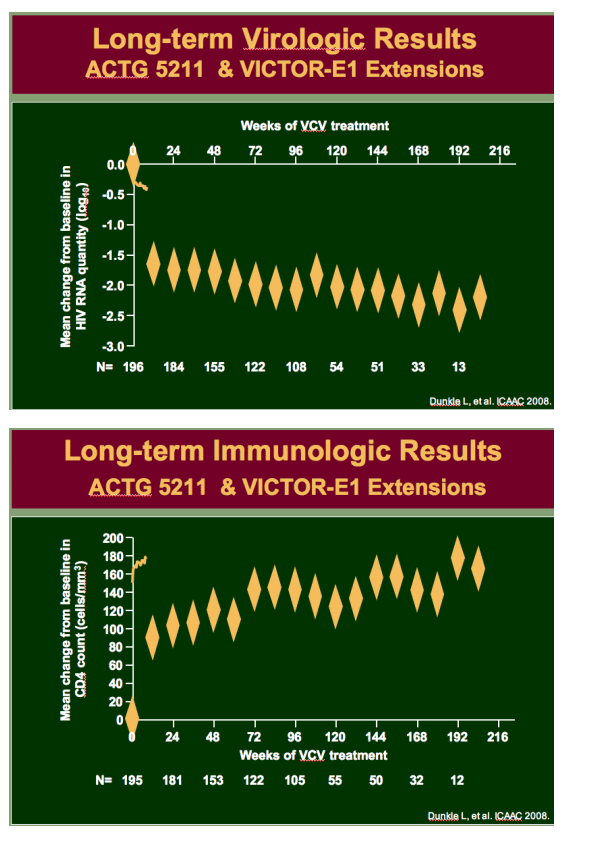
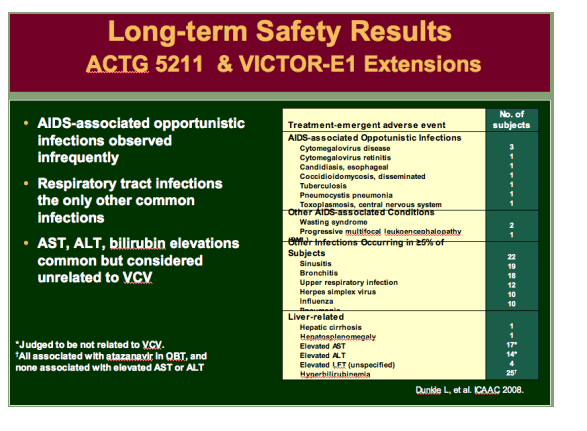
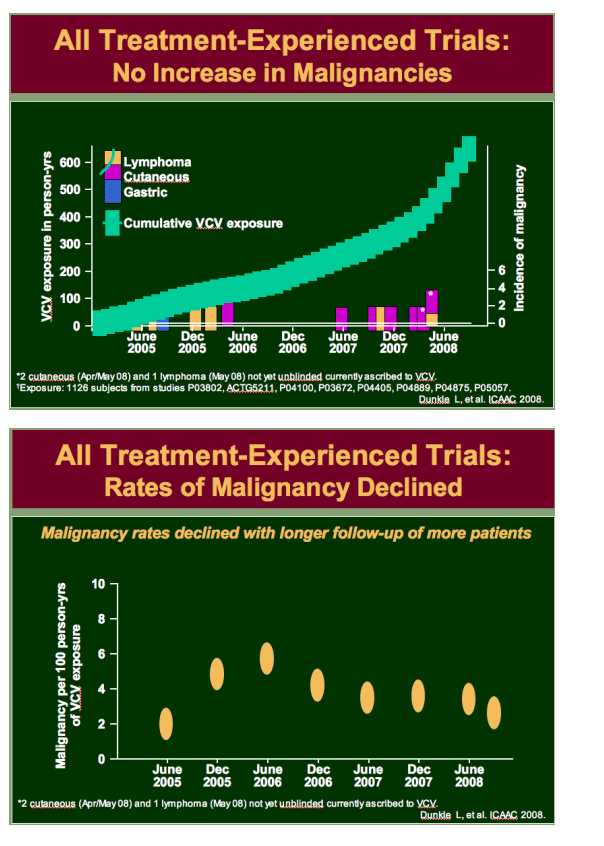
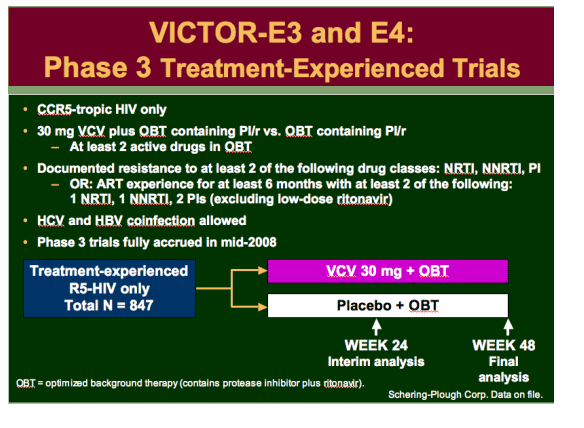
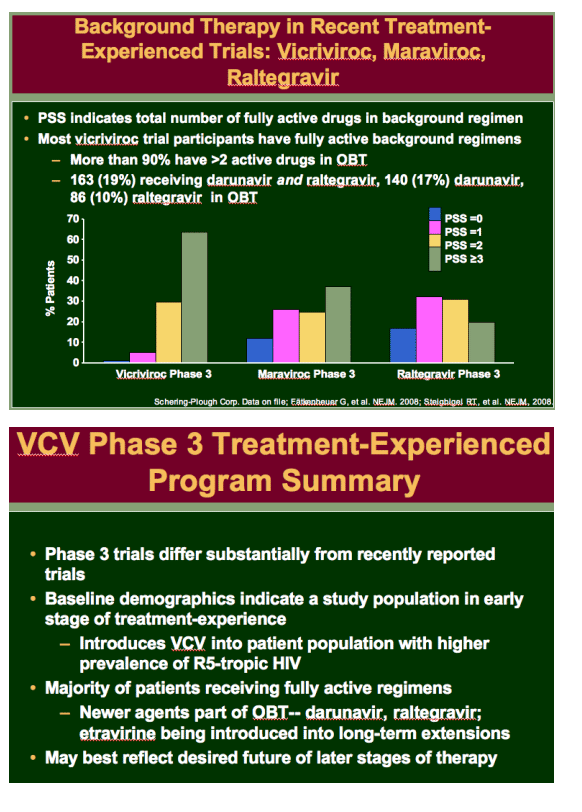
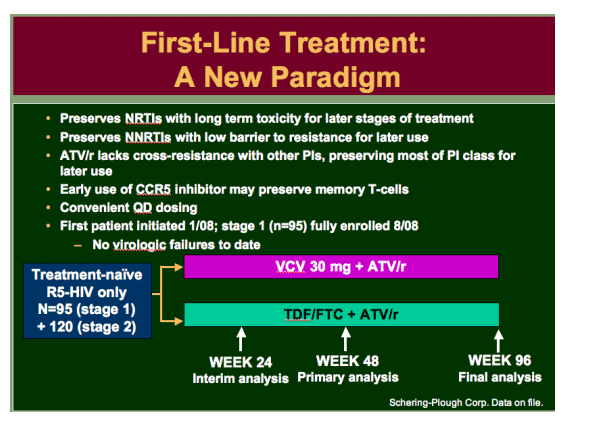
_References_1. Dunkle L. Vicriviroc: improving HIV therapy via CCR5 antagonism. Targeting HIV Entry: 4th International Workshop. December 8-9, 2008. Rio Grande, Puerto Rico. Invited lecture._2. Zingman B, Suleiman J, DeJesus E, et al. Vicriviroc, a next generation CCR5 antagonist, exhibits potent, sustained suppression of viral replication in treatment-experienced adults: VICTOR-E1 48-week results. 15th Conference on Retroviruses and Opportunistic Infections. February 3-6, 2008. Boston. Abstract 39LB._3. Schering-Plough Corporation. Data on file. Presented by Lisa Dunkle on December 9, 2008._4. Gulick RM, Su Z, Flexner C, et al. Phase 2 study of the safety and efficacy of vicriviroc, a CCR5 inhibitor, in HIV-1-Infected, treatment-experienced patients: AIDS Clinical Trials Group 5211. J Infect Dis. 2007;196:304-312._5. Saag M, P Ive, J Heera, et al. A multicenter, randomized, double-blind, comparative trial of a novel CCR5 antagonist, maraviroc versus efavirenz, both in combination with Combivir (zidovudine/lamivudine), for the treatment of antiretroviral naive patients infected with R5 HIV-1: week 48 results of the MERIT study. 4th International AIDS Society Conference on HIV Pathogenesis, Treatment, and Prevention. July 22-25, 2007. Sydney. Abstract WESS104.
|
| |
|
 |
 |
|
|